Age of Jackson
Jackson's Legacy
Jackson retired to his plantation, the Hermitage, near Nashville. However, he remained active in Democratic politics until his death in 1845.
During his lifetime, he was considered a champion of the common man and democracy. Even after his death, historians called the time he lived as “the age of Jackson” and said he developed “Jacksonian Democracy.”
Many of things Jackson believed in are now widely accepted. He thought people, not legislatures, should elect each state’s U.S. senator. This was changed in 1912 when the 17th amendment was passed.
However, Jackson also thought the electoral college should be abolished and that the president should be elected directly by the people. Presidents today are still elected by the electoral college.
However, Jackson also thought the electoral college should be abolished and that the president should be elected directly by the people. Presidents today are still elected by the electoral college.
Jackson also was a staunch unionist. When South Carolina attempted to nullify or cancel a law passed by Congress, Jackson threatened them with U.S. troops. Thirty years later, President Abraham Lincoln would rely on Jackson’s interpretation to justify going to war to preserve the Union.
Jackson is judged negatively by some today because of the Indian Removal Act of 1830, which he proposed. Even though the Trail of Tears didn’t happen until another president was in office, many blame Jackson for the tragedy.
Ultimately the fact that Andrew Jackson, a self-made, common man, could become president was a symbol for this period. It was democracy in its basic form.
Picture Credits:
- Print showing Andrew Jackson with the Tennessee forces on the Hickory Grounds. It depicts a scene during the Creek War at the Hickory Grounds in Alabama territory in 1814. Jackson is shown riding his horse while the background shows soldiers are in battle. Library of Congress.
- Portrait of Andrew Jackson possibly by John Wood Dodge. It shows Jackson as an elderly man. Tennessee State Museum Collection, 76.67.
- Political cartoon entitled, “The Great White Father.” It depicts Andrew Jackson as a large Father, surrounded by Indians, who are shown as small adults sitting on his lap and standing near his feat. Public Broadcasting Service.
- Print entitled, “Death of General Andrew Jackson.” This print was made in 1845. It shows Jackson in bed, while four grieving people are shown standing, praying, and sitting near his bedside. Tennessee State Museum Collection, 76.156.
- Print entitled, “The Grand Funeral Procession in Memory of General Andrew Jackson.” This print was made in 1845 by H. R. Robinson. It shows Jackson’s coffin being pulled by a team of horses while numerous soldiers march in line in the background. Tennessee State Museum Collection, X79.36.
- Print entitled, “The re-union of the home of the brave and free!” This print was made in 1863 by Samuel Canty. It depicts the reconciliation between the North and South after the Civil War. It shows Andrew Jackson on the left and George Washington on the right above two rows of women holding the arms of the thirty-four states then comprising the United States. Library of Congress.
- Print entitled, “Death of Genl. Andrew Jackson.” It was published on July 15, 1845. It shows Jackson in bed surrounded by Mrs. Adams, Major Lewis, a physician, Mrs. Donelson, and Major Donelson. The little girls probably include his granddaughter Rachel Jackson Lawrence. Library of Congress.
Age of Jackson >> Tennessee's Presidents >> Andrew Jackson >> Jackson's Legacy
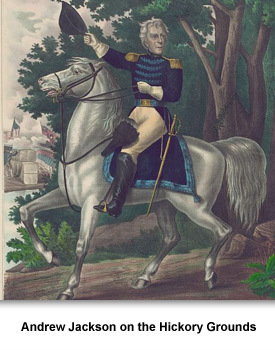
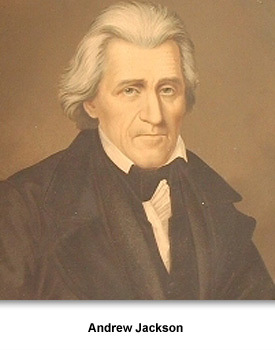
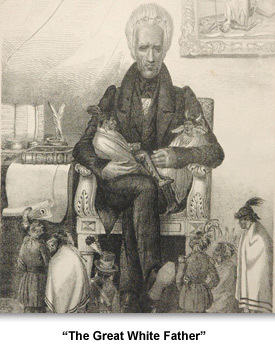
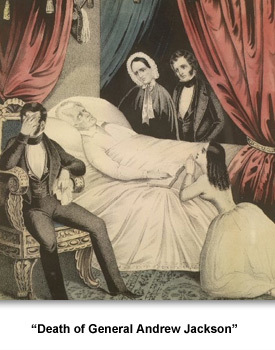
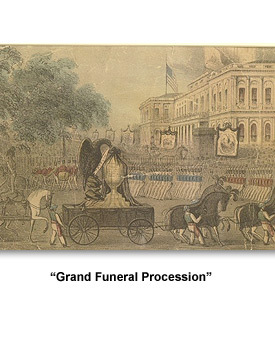
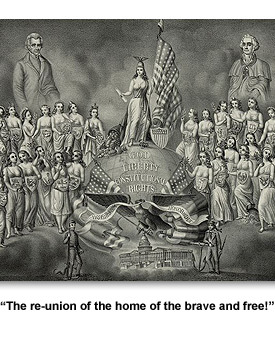
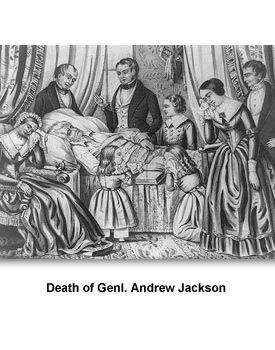
 Sponsored by: National Endowment for the Humanities
Sponsored by: National Endowment for the Humanities